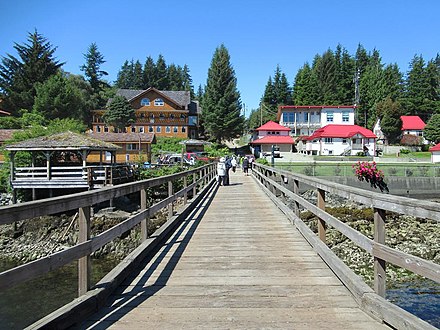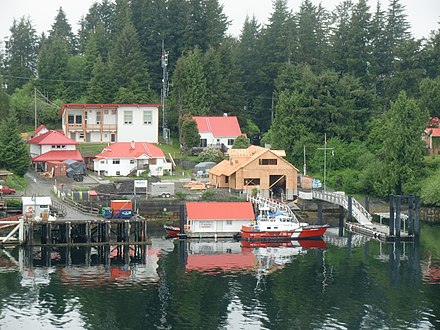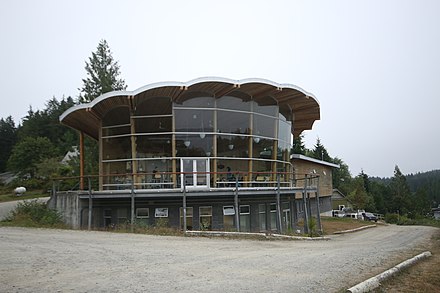Bamfield - human settlement in British Columbia, Canada
Bamfield is a small coastal town of about 180 people (2016) in Central Vancouver Island. It is divided by Bamfield Inlet. Bamfield is a tourist destination for the West Coast Trail, ocean kayaking and sport fishing.
Understand
 Bamfield was populated by Huu-ay-aht of the Nuu-chah-nulth, the local indigenous people. Europeans founded a small fishing community sometime in the late 1800s. Most of the indigenous people now live in the neighbouring village of Anacla about 5 km from Bamfield.
Bamfield was populated by Huu-ay-aht of the Nuu-chah-nulth, the local indigenous people. Europeans founded a small fishing community sometime in the late 1800s. Most of the indigenous people now live in the neighbouring village of Anacla about 5 km from Bamfield.
Bamfield was named after the first government agent of the area, William Eddy Banfield. The name "Bamfield" with an "m" is said to be either due to how the local First Nations people had trouble pronouncing the letter "n" in his name, or a mistake made by the post office. In 1902, the Bamfield cable station was constructed as the western terminus of a worldwide undersea telegraph cable called by some the All Red Line as it passed only through countries and territories controlled by the British Empire, which were coloured red on the map. The cable went to Fanning Island, a tiny coral atoll in the mid-Pacific, and from there continued to Fiji, New Zealand, and Australia. A second building, made of concrete, was built on the site in 1926 to replace the old wood structure. This building, designated a historic site in 1930, is now used by the Bamfield Marine Sciences Centre.
A Marine and Fisheries lifesaving station on the Pacific coast was established at Bamfield in 1907. It was the first lifesaving station on Canada's Pacific Coast.
In 1953 the cable was extended up the Alberni Inlet to Port Alberni and the local station was closed in 1959. In 1972, the site was converted into a marine biology research station, the Bamfield Marine Sciences Centre. It became the largest employer in the community.
Commercial fishing was based in Bamfield up to the mid-1980s. Bamfield is now home to several sport fishing lodges, which pursue primarily salmon and halibut. Bamfield is also the northern terminus of the West Coast Trail, a hiking trail built in 1907 along the west coast of Vancouver Island to help survivors of the area's many shipwrecks find their way back to civilization. The trail runs 77 km (48 mi) along extremely rugged terrain.

Get in
By plane
- Pacific Seaplanes, sales@pacificseaplanes.ca. Operates seaplane flights to a few smaller coastal communities in southwestern British Columbia. 2022-04-25 Operates seasonal seaplane services to Bamfield from Vancouver (45 minutes) and Port Alberni (15 minutes) between May 1 and September 30.
By boat
- Lady Rose Marine Services, +1 250-723-8313, ladyrosemarine@telus.net. Provides ferry service from Port Alberni three times weekly on Tu, Tu and Sa. Trip departs Port Alberni at 8AM and takes about 4 hr 30 min. Service is restricted to residents of Bamfield, Haggards Cove and Kildonan only due to COVID-19. Adults $47.50 one-way, child (8-15) $23.75, child (under 8) free
By bus
- West Coast Trail Express, +1-250-477-8700. Seasonal service allowing hikers of the West Coast Trail to reach the northern (Bamfield) and southern (Port Renfrew) ends of the trail. Operator runs a bus route to Bamfield and Pachena Bay from Victoria, with stops along the way at Port Renfrew and the Juan de Fuca trail head. Also operates a bus route to Bamfield from Nanaimo. Travel time from Victoria is 6 hours, Port Renfrew is 4 hours, and from Nanaimo is 3 hr 45 min. The routes operate from May 1 to September 30. 2022-03-26
By car
Bamfield is only road accessible via logging roads (smooth to rough gravel). You are likely to encounter logging trucks, which have the right of way. Pull over and let them pass or risk getting honked! Check your spare tire, and make sure you have a full tank of gas. There is a gas station in Bamfield.
From Port Alberni
There is a signposted route from Port Alberni, marked with red and white kilometer signs from 1 to 76. The road is usually well maintained, and is 76 km, taking 1.5 - 2 hr.
From Duncan
A signposted, but less well maintained route from Lake Cowichan (on Hwy 18) is around 120 km, and takes 3-4 hours. Head north pass Duncan on Highway #1 and turn west to Cowichan Valley Highway (Highway 18). After passing Youbou, continue west on gravel logging road to reach Bamfield.
Get around
To cross between East and West Bamfield, get a water taxi. Call for one on the two way radios stationed on or near most major public docks. Remember to turn the radio off after use!
- Bamfield Pachena Taxi - Contact Susan at +1 250-728-3363. (June 2018)
See

- Bamfield Marine Sciences Centre, 100 Pachena Rd, 48.835262°, -125.1355°, +1 250-728-3301, info@bamfieldmsc.com. BMSC offers tours to the general public in July and August (suspended due to COVID-19). Discover the natural history of Barkley Sound. Experience the unique history BMSC shares with the village of Bamfield. Learn about the coastal science research taking place at BMSC. Scheduled tours are offered Wednesdays, Fridays, & Saturdays from 1–2PM and begin from the traffic circle outside the Main Building. First tour is July 4th. A suggested donation of $5 per adult or $10 per family. 2022-08-24
Do
- Brady's Beach, 48.8275°, -125.1526°. A great strip of sand and rock pools that are full of life at low tide. 2018-06-27
Buy
- The Market and Cafe (Tides & Trails), 242 Frigate Road, 48.8261°, -125.1339°, +1 250-728-2000, marketmanager@huuayaht.com. Open year-round and sells a variety of groceries from staples such as milk and bread, to fresh deli items, slushies, and soft-serve ice cream. There is also a wide assortment of giftwear. The Café is open seasonally from March to October and is casual dining. 2022-08-24
Eat and drink
- Malsit Public House, 227 Frigate Road, 48.8264°, -125.1351°, +1 250-728-3422. Closed due to COVID-19. 2022-08-24
- Bamfield Cafeteria, 48.8352°, -125.1345°, +1 250-728-3301. 2022-08-27
Sleep
- Hacas Inn, 226 Frigate Road, 48.826°, -125.1346°, +1 250-728-3231, frontdesk@huuayaht.com. Check-in: 3PM, check-out: 11AM. From $199 2022-08-24
- Upnit Lodge and Marina, 211 Nuthatch Road, 48.8282°, -125.1366°, +1 250-728-3231, info@upnitlodge.ca. Check-in: 3PM, check-out: 11AM. From $299 2022-08-24
- Pachena Bay Campground, 90 Anacla Rd (5 km south of Bamfield), 48.7974°, -125.1249°, +1 250-728-1287, Info@PachenaBayCampground.ca. Check-in: 2PM, check-out: 11AM. Full-service camping sites for RVs, campers, and tents. All of their sites offer campers the option of power & water hookups. Washroom facilities, hot showers, flush toilets, fully wheelchair-accessible. Apr-June, Sep 6-Oct 10: RV $55-60, tent $39-55; Jul Aug Sep 1-5: RV $69-75, tent $45-69 2022-08-24
- McKay Bay Lodge, 48.8251°, -125.1418°, +1 250-728-3323, mckaybay@island.net. Has fishing and boat docks. 2022-08-27
Connect
Go next
Bamfield
vancouverisland.com/regions/towns/?townID=26Date Time:Please wait...Timezone:America/VancouverCoordinates:48.83, -125.14
Regional District of Alberni-Clayoquot
2nd-order administrative division
British Columbia
Primary administrative division